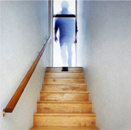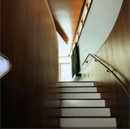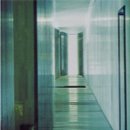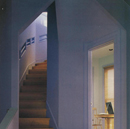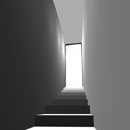
Compelling Light
Compelling Light refers to bright illumination perceived from a dark passage. One experiences an irresistible urge to move towards the light. more
Compelling Light | House
application
In residential design, Compelling Light refers to bright natural or artificial light perceived from a dark hallway, stair, or small space. This trait implies motivation, the impulse to move toward the light.
research
Compelling Light primarily consists of an exterior natural light that is allowed to enter the interior space through an opening, a window, or glass door finalizing or perceived as at the end of a long corridor, stairwell, or an enclosed space. In other cases, it consists of an artificial effect produced by electrical lighting. Compelling Light is so intense in contrast with the surrounding darker environment, that it accelerates movement towards it. The effect is further intensified when used in stairwells. As the risers increase in height the movement becomes slower, whereas as they decrease the movement becomes faster. According to Vodvarka, the kinesthetic experience is suggested as a role of spatial design, “particularly where the interaction of body movement and its spatial envelope is intense.”1
Thereby, the more enclosed the space or tighter the walls, the greater the intensity of experience as one moves toward Compelling Light. “Procession can be encouraged by light. We tend to follow light. Light can beckon us down a path... Movement is encouraged by light at the destination.”2
According to the setting, light ending a pathway can be understood differently and thereby possesses different meanings. Light as hope is present in the house of monks as a reminder of the outside world. Tiny windows within the heavy building enclosure are reminiscent of a remote world, in contact only through prayer. In the Monastery of S. Martin du Canigou in France, constructed in 1026, Compelling Light was achieved by aligning the central corridor to the altar room and thereby the small windows behind it. Low arches restricted the addition of side light into the space, further emphasizing the awareness of Compelling Light.
The meaning of Compelling Light varies with the evolution of corridors in time according to new spatial solutions. With the development of corridors in the 17th century, Compelling Light made its debut into the residential interior. An ending light became the solution to the new dark hallways that were being created for room distribution. Attracting most of the attention and as an escape, Compelling Light meant a relief from an obscure interior to a lit exterior. Other than a relief, Compelling Light as a symbol of status was used in 1910 by Edward Lutyens in Castle Drogo. Luyens wanted to provide his clients with “a sense of belonging to an aristocratic tradition”.3 As interior spaces evolved into an open plan, the existence of the corridor or enclosed space blurred. Thereby in the 1920s and 1930s, examples of Compelling Light were not found in publications.
In the 1940 decade Compelling Light is reiterated in a slightly different way. For example, in 1947 Marcel Breuer ended the narrow corridor of his own house with a lit room. At its culmination, the corridor expanded into a larger space surrounded by glass walls that allow light in and make the room seem lit.
In the 1970s, the intensity of Compelling Light decreased as lateral lights were introduced into the hallway. Rooms punctuate the hallway and introduced light from their windows into the once dark space, as seen in the house designed by Hobart Betts in 1975.
In the 1990s, lateral lights are organized in a repetitive and sequential manner along the ceiling and walls of corridors. These lights, although distracting, emphasize the linear movement towards Compelling Light; as observed in the residential work of Dean/ Wolf Architects and architect Richard Brayton. It is not until the 21st century that spatial compositions allow Compelling Light to fully reappear, and it does so in a dramatic way. Narrow corridors and steep stairwells that uncomfortably squeeze the human figure and push it out create an urgency to reach the compelling light. Furthermore, a sense of discovery and surprise was introduced through curved and angled corridors that with their turns raise the expectations of arrival towards the light. Also, artificial light is now used to resemble the once natural light, making possible its use in indoor corridors that cannot be in direct contact with the outside.
Artificial light changes the quality of Compelling Light making it harsher than before, almost chemical. Finally, spaces manipulated in three dimensions play with the human senses and thus alter perception. In 2003, in Mexico, architect Javier Senosiain Aguilar designed a corridor that suggested Compelling Light although it did not exist. He painted a far end wall pure white, contrasting it with the darker, orange corridor.4
end notes
- 1) Joy Monice Malnar and Frank Vodvarka, The Interior Dimension: A Theoretical Approach to Enclosed Space (New York : Van Nostrand Reinhold, 1992), 237-8.
- 2) Marietta S. Millet, Light Revealing Architecture (New Jersey: John Wiley & Sons Inc., 1996), 118.
- 3) John Pile, A History of Interior Design (New York: John Wiley & Sons Inc., 2000), 265.
- 4) Evidence for the use and the chronological sequence of Compelling Light as a house archetype was developed from the following sources: 1970 Private House [1975] Hobart Betts; Englewood, NJ; in "Record Houses 1975," Architectural Record, Record Houses of 1975 (May 1975): 56; PhotoCrd: Bill Maris / 1980 Mixon House [1985] Houston, TX; in "Mixon House Houston, Texas by Taft Architects," Architectural Record, Record Houses 1985 (Mid-Apr. 1985): 138; Paul Warchol; Crowell House [1985] Mark Simon, Centerbrook; Eastern Shore, Long Island, NY in "Crowell House," Architectural Record, Record Houses (Mid-Apr. 1985): 121; PhotoCrd: Timothy Hursley/The Arkansas Office / 1990 Zumikon House [1995] Gwathmey Siegel and Associates Architects; Lake Zurich, Zumikon, Switzerland in Tracy Metz, "Living with Art," Architectural Record 66, no. 4, Record Houses 1995 (Apr. 1995): 79; PhotoCrd: Richard Bryant/Arcaid; Spiral House (Dr. Andrew and Lisa Goldberg House) [1995] Dean Wolf Architects; North Castle, NY in Charles K. Hoyt, "Hitting Bedrock," Architectural Record 183, no. 4 (Apr. 1995): 67; PhotoCrd: Peter Aaron/Esto Photos; Richard Brayton House [1997] Richard Brayton, Brayton & Hughes; Pacific Heights, CA in Henry Urbach, "The Streets of San Francisco," Interior Design 68, no. 9 (July 1997): 111; PhotoCrd: I.D. Peterson / 2000 Wallace Neff House [2003] Patrick Tighe; Los Angeles, CA in Edie Cohen, "From Capri to California," Interior Design 74, no. 12 (Oct. 2003): 177; PhotoCrd: Art Gray; Javier Senosiain Aguilar House [2006] Javier Senosiain Aguilar; Mexico City, Mexico in Raul Barreneche, "In the Belly of the Beast," Interior Design 74, no. 8 (June 2003): 173; PhotoCrd: Sofia Brignone; Dallas Austin House [2006] Architropolis Corporation, Michael Czysz, Architect; Atlanta, GA in Georgia Dzurica, "The Starship Serenity," Interior Design 77, no. 1 (Jan. 2006): 189, 190; PhotoCrd: Eric Laignel; Casa Tolo [2006) Álvaro Leite Siza Vieira; Lugar das Carvalhinhas, Portugal in Clifford A. Pearson, "Casa Tolo," Architectural Record 77, no. 4, Record Houses 2006 (Apr. 2006): 135; PhotoCrd: FG+SG/Fernando Guerra; New England House [2006) Office dA; New England in Fred Bernstein, "House in New England," Architectural Record 77, no. 4, Record Houses 2006 (Apr. 2006): 119; PhotoCrd: John Horner Photography.
bibliographic citations
1) The Interior Archetypes Research and Teaching Project, Cornell University, www.intypes.cornell.edu (accessed month & date, year).
2) Mendez, Marta. “Theory Studies: Archetypical Practices of Contemporary House Design.” M.A. Thesis, Cornell University, 2008, 44-52.

